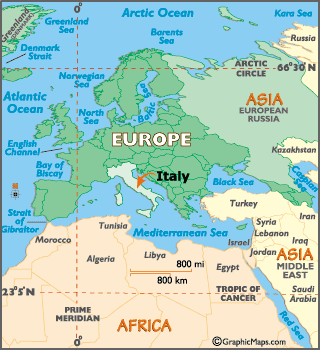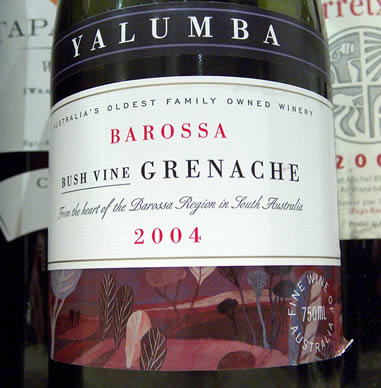Wine Region: All About Tuscany
Fig 1.: Italy in relation to Europe and world
Tuscany is
known for its rolling hills, bright sunshine, acres of olives, small villages
and coastal climate. Of course, Tuscany is also known for it’s wines,
predominantly, Chianti. Tuscany makes great wines as a result of the sand and
clay soils which lead to complex but balanced wines. Further, Tuscany has a
variety of microclimates, and the vineyards are at a unique altitude in the
mountains, lying somewhere between 150-500 meters. The region is known for
producing balanced wines, with an ideal ratio of sugar to acid. Tuscany doesn’t
only boast Chianti, however. There are 6 wines with appellation D.O.C.G.
(Designation of Origin Controlled and Guaranteed including Chianti Classico,
and Brunello di Montalcinio, and 30 wines with appellation D.O.C. (Designation
of Origin Controlled). The DOCG controls the classification of all Italian
wines, and started regulating in 1963, even though this region has been an official
wine producer. The DOCG monitors what grape varieties can be used in wines with
specific labels and regions, and how certain wines can be produced. The DOC is
slightly less prestigious and monitors the majority of wines in Italy and these
regulations are slightly more lax. If a wine doesn’t meet the criteria set out
by either of these organizations, it is labeled VDT, for table wine. Tuscany is
located in central west Italy, and includes eight appellations (sub regions),
the major ones are as follows: Chianti, Brunello di Montalcino, Vino di Tavola
(the Super Tuscans), Vino Nobile di Montepulciano and Vernaccia dia San
Giminganon.


Fig. 2 and 3: Tuscany, Italy and the Primary Wine Regions of Tuscany
A Closer Look at the Major Sub-Regions of Tuscany:
Chianti: Chianti is known as the drink of Tuscany,
and has become ever-popular in the states as a staple of American-Italian
dining. The Chianti sub-region is
known for growing the Sangiovese grape, which makes up approximately 90% of the
Chianti region. The Chianti region is the most well-known area of Tuscany,
heard of by even novice wine drinkers (like myself!). Chianti was exported
since the 1700’s, and has since made a name for itself worldwide. It must be at
least 75% Sangiovese, and there can be 10% Canaiolo and up to 20% of other
approved grapes in the region (for example, Merlot or Syrah). The addition of
other grapes ensures that a stable and balanced wine can be made, even if a
hard year hits the Sangiovese varieties. These other grapes add complex flavors
and add to the Chianti experience as well. Chianti labeled Reserva indicates
that it has been extensively aged, and was made with extremely rich and ripe
grapes. This is the best of the best. Within this sub-region, there are further
designations for different kinds of Chianti. For example, Chianti Classico is a
small area of land, about 100 square miles, that has a slightly different soil
and climate than the rest of Chianti because it is higher in the mountains.


Fig. 4 and 5: Example of Chianti Classico Label and a 100% Merlot Masseto.
Brunello di Montalcino: Brunello di Montalcino is
produced from 100% Sangiovese and is always aged for at least 50 months. This
region’s wines are known for being lower in acid than Chianti and for having
darker and more leather-like flavors. Interestingly enough, this wine may be
produced from Sangiovese Grosso too, a clone of Sangiovese which produces the
darker flavors of the characteristic wine. Brunello di Montalcino is warmer and
drier than in Chianti.
Vino di Tavola: Vino di Tavola is now best known for
its Super Tuscans. It is important to recognize the Super Tuscans in this
region, because they have made quite a name for themselves in the past few
decades. In the 1970’s, winemakers started to break traditional winemaking
rules and began to bring in new grape varieties, and started using new French
oak barrels for aging. For example, sometimes merlot or Cabernet Sauvignon was
added to traditional Italian wines, clearly breaking the DOCG and DOC’s wine
regulations. The wines were then labeled VDT, and were less marketable as a
result. However, these wines were extremely well-received by the global
population. To compromise, today, the IGT (Indication of Geographical Type)
category of regulations has been added. This allows the labeling of sub-Tuscan
regions that a wine is from, thus allowing more flexibility for the wine-maker
to experiment in Italy.
Vino Novile di Montepulciano: This area is known for
making wines with a minimum of 70% Sangiovese that is then aged for at least 2
years in a barrel. They have a lot of umph and are very complex.
Vernaccia di San Gimignano: Vernaccia is a white
grape grown in this area, and is known for making a very dry wine. Sometimes,
they taste like rocks, a flavor influence from the minerals in the soil.
We have already talked a bit about Sangiovese, but
let’s get more specific about what the major Tuscan grapes brings to the table.
The Sangiovese varietal is the most planted grape in all of Italy. It
characteristically has a high yield and late ripening, and it specifically
requires well-drained limestone soils and a hot climate. The grape is thin
skinned but can age very well and goes best when paired with food such as tomatoes,
pasta and light meats. Tuscany also grows renowned Cabernet Sauvignon and
Merlot varieties. As for the whites, Trebbiano is the common, and makes up 1/3
of Italy’s white wine production. This wine is fresh and crisp, high in acidity
and doesn’t have many pronounced flavor, often being described as bland.
Tuscany also grows Vernaccia (the only white wine in Tuscany labeled DOCG). One
wine that is very unique to Tuscany is Vin Santo. This is a dessert wine made
from the Trebbiano grapes. They are dried by air after harvest until the
beginning of Holy week before they are fermented into wine.
It was not possible to find how many wineries are in
Tuscany, but there are 64,000 hectares of vineyards in the region, of which 70%
are reds.
Fig. 6: Vineyards in Tuscany, Italy
Navigating the many wines of Tuscany can be a
challenge, but with knowledge about the Italian labeling system, much
information may be derived without having intimate knowledge of the wine
itself. Most labels will feature
their quality classification (If it is a DOCG wine ect), the appellation (for
example, Chianti Rufina), the year, the brand name (but more often
the name of a particular house), the address and name of the producer
(different than in the US!), and the usual contents, such as vintage, alcohol
content and volume. It is valuable to look for the word ‘Riserva,’ because this
indicates that the wine has been aged for longer than other wines. This also
indicates a more expensive wine!
Tuscany
one of the best regions in the world for wine, and I hope to be able to visit
this enchanting land one day.
 We all know that pinot noir is just not so good below a certain price point, but I thought I'd give a cheapo a whirl. It wasn't anything special. Although it claims to be balanced, it was too high in tannins for my taste and the vanilla and strawberry didn't shine through. It did feel a little "chewy," as in not very thin/watery. This wine may have been better with some food, maybe a red sauce with pasta.
We all know that pinot noir is just not so good below a certain price point, but I thought I'd give a cheapo a whirl. It wasn't anything special. Although it claims to be balanced, it was too high in tannins for my taste and the vanilla and strawberry didn't shine through. It did feel a little "chewy," as in not very thin/watery. This wine may have been better with some food, maybe a red sauce with pasta.
 NV Cupcake Vineyards
NV Cupcake Vineyards













